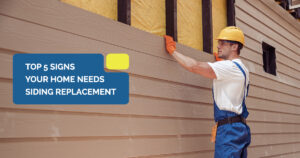The siding on your home serves a critical purpose: protecting your home's exterior from damage due to weather, pests, and environmental stressors. However, over time, siding itself can also become damaged, leading to costly repairs and potential issues with your home's curb appeal and resale value.
In this article, we will explore common causes of siding damage and how to prevent them, giving you the confidence to ensure your home remains in top condition for years to come.
Common Causes of Siding Damage
Over time, siding can become damaged due to a variety of factors. Here are some of the most common causes of siding damage:
1. Weather damage
The weather is the most common cause of siding damage. From hail storms to intense sun exposure, severe weather conditions can wear down your home’s siding over time. Fortunately, you can help prevent damage by inspecting your siding regularly and making necessary repairs.
2. Moisture damage
One of the biggest culprits of siding damage is moisture. When water penetrates the siding, it can lead to rot, mold, and mildew, causing significant damage to your home's exterior. To prevent moisture damage, it's important to ensure that your gutters are clean and free of debris so that water is directed away from your home. Additionally, you can consider waterproofing solutions and investing in high-quality siding materials that are less prone to moisture damage.
3. Pest damage
Another common cause of siding damage is pests, including termites and rodents. These pests can chew through siding materials, causing holes and cracks that can become breeding grounds for mold and other harmful substances. To prevent pest damage, it's important to seal any cracks or openings where pests could enter your home and to invest in pest-resistant siding materials such as fiber cement or vinyl.
4. UV damage
Over time, UV rays can cause the color of your siding to fade, and can even cause warping, cracking or splitting in some cases. To prevent UV damage, you can invest in siding materials that have built-in UV protection or opt for siding that is painted using fade-resistant colors. Shade-giving trees planted on the side of your house can also help to reduce the damaging impact of the sun.
5. Poor Maintenance
Lack of maintenance is also a leading cause of siding damage. Over time, dirt, grime, and other debris can accumulate on your siding, causing damage and even mold growth. Regular cleaning and maintenance can help prevent this.
How to Prevent Siding Damage
Siding damage not only reduces the aesthetic appeal of your home, but it can also lead to significant problems such as water damage and mold growth. However, taking some necessary precautions and following proper maintenance techniques can save you thousands of dollars in the long run. Here are some effective tips to prevent common causes of siding damage.
1. Regular Inspection
Consistent inspection of your siding can save you from severe damage in the long run. Check for any warped, cracked, or buckled sections of the siding and replace them immediately. Try inspecting your sidings after every season change, as it's an opportune time to catch damage after severe weather conditions.
2. Recurring Maintenance
Frequent inspection and maintenance are crucial to prevent siding damage. You should inspect the siding of your house every few months for any signs of damage, including cracks, chips, and warping. For larger maintenance tasks, such as cleaning or painting, contact a professional siding contractor like Pro Roofing & Siding.
3. Trimming Plants
Trimming plants and trees near your home is another effective way to control siding damage. Overhanging tree branches can scratch or damage your siding during high winds or inclement weather. Trimming away any overhanging branches, shrubs or bushes keeps the siding safe and away from danger.
4. Proper installation
Proper installation is the first line of defense against siding damage. Ensure that the siding contractor you choose has sufficient knowledge and expertise. This includes proper insulation under the siding, application of trim and caulking in areas where water penetrates, and a proper amount of ventilation between the siding and home's framework. By entrusting the job to experts you can be sure that your siding is installed for maximum protection.
Need Help Dealing with Siding Damage?
By following these tips, you can help protect your home from siding damage and ensure that it maintains its curb appeal and resale value for years to come. At Pro Roofing & Siding, we offer siding repair and replacement services for homeowners throughout Metro Atlanta. With 15+ years of experience, we are ready to help you with any type of siding issue. Contact us today for a free estimate.





